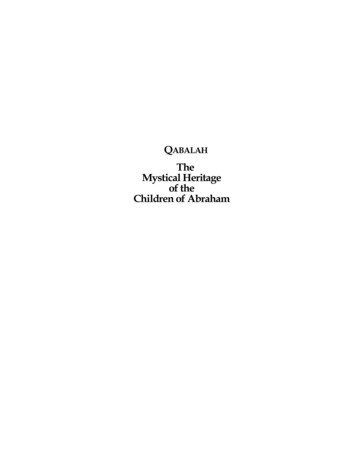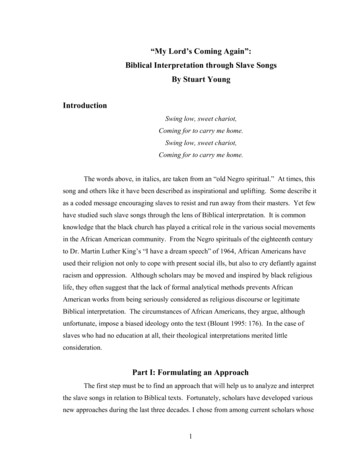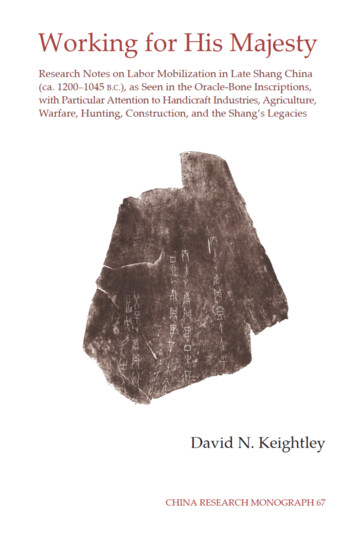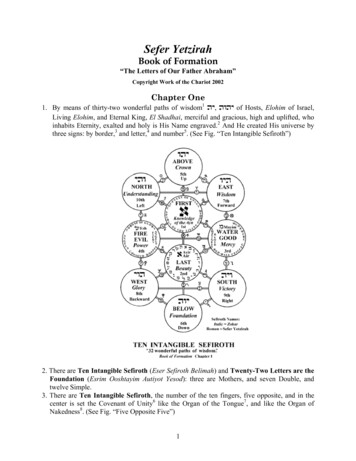
Transcription
4 % / & 37(5 7KH0\VWLFDO HULWDJHRI WKH&KLOGUHQ RI EUDKDP&KDSWHU
7 ( 23(1 * 7(µ
QABALAHThe Mystical Heritage of the Children of AbrahamPublished by:Work of the ChariotPost Office Box 5162Santa Cruz, CA 95063-5162 U.S.A.www.workofthechariot.comCopyright 2001 by Daniel Hale FeldmanAll rights reserved. No part of this book may be reproduced,stored, or transmitted in any form or by any means, electronic,chemical, optical, or mechanical, including photocopying,recording, or by any information storage and retrieval system,without written permission from the author. Reviewers mayquote brief passages.International Standard Book Number: 0-9701360-4-8Library of Congress Catalog Card Number: 00-19109110 9 8 7 6 5 4 3 2 1Printed in the United States of America
&RQWHQWV XWKRU·V 6WDWHPHQW ,QWURGXFWLRQ &KDSWHU %DFNJURXQG )URP 7HQWV WR 7HPSOHV WR 5DEELQLFDO 6HFWV :KDW LV WKH 0\VWLFDO 4DEDODK RI WKH &KLOGUHQ RI EUDKDP" 0\VWLFDO 4DEDODK DQG 3UDFWLFDO HUPHWLF .DEEDODK 0\VWLFDO 4DEDODK DQG 5DEELQLFDO -HZLVK .DEEDODK 0\VWLFDO 4DEDODK 0\VWLFDO &KULVWLDQLW\ DQG WKH &KULVWLDQ &DEDOD 0\VWLFDO 4DEDODK DQG WKH 0\VWLFDO 7UDGLWLRQ RI ,VODP HEUHZ 4DEDODK DQG 1RUWK ,QGLDQ 7DQWUD 0\VWLFDO 4DEDODK 3K\VLFV DQG VWURSK\VLFV &KDSWHU 6RXUFHV RI WKH 0\VWLFDO 4DEDODK ,QWURGXFWLRQ 6HIHULP D7RUDK %RRNV RI WKH /DZ 6HIHU D6KPRWK %RRN RI WKH 1DPHV 6HIHU HW]LUDK %RRN RI )RUPDWLRQ 6HIHU D RKDU %RRN RI 6SOHQGRU 0D·VHK 0HUNDEDK &KDULRW /LWHUDWXUH 7KH 3HVKLWWD DQG WKH 5HYHODWLRQ RI -RKQ 7KH 4X·UDQ 7KH (W] D&KD \LP 7UHH RI /LIH RI 5DEEL LW]D·DT /XULD &RQFOXVLRQ 5HJDUGLQJ WKH 3ULPDU\ 7H[WV &KDSWHU &RUH 7HDFKLQJV RI WKH 0\VWLFDO 4DEDODK ,QWURGXFWLRQ 7KH \Q 9DVW )DFH DQG 6PDOO )DFH 7KH \Q 9DVW )DFH 6PDOO )DFH &RQFOXVLRQ 7KH 4DEDOLVWLF 7UHH RI /LIH ,QWURGXFWLRQ 7KH &RPSRVLWLRQ RI WKH 7UHH RI /LIH 7KH )RXU 4DEDOLVWLF :RUOGV 7KH 4OLIRWK 6KHOOV RI (PERGLHG &RQVFLRXVQHVV 7KH 7UHH RI /LIH DQG WKH )DOO RI GDPµ hvhy ³ WKH 3HUIHFW 1DPH IURP 127µ hvhy DQG WKH 1DWXUH RI 0HVVLDQLF SSHDUDQFH
&KDSWHU 7UHHV RI /LIH IURP WKH 6HIHU D6KPRWK DQG WKH 6HIHU HW]LUDK QJHOLF 7UHH /DQJXDJH RI WKH 6HIHU D6KPRWK ,QWURGXFWLRQ 7KH :D\ RI WKH QJHOV RI (ORKLPµ DQG WKH :D\ RI WKH QJHOV RI 'HVWUXFWLRQµ 7KH :D\ RI WKH 6DLQWµ DQG WKH :D\ RI WKH :L]DUGµ &HQWUDO &ROXPQ :RUNLQJ 3DWKV 7UHHV RI 3HUIHFWLRQ 7UHHV RI /LIH IURP WKH 6HIHU HW]LUDK %RRN RI )RUPDWLRQ &KDSWHU 7UHHV RI /LIH IURP 2WKHU 3ULPDU\ 4DEDOLVWLF6RXUFHV DQG 2WKHU 0\VWLFDO 7UDGLWLRQV 0HUNDEDK 7UHH IURP WKH %RRNV RI (]HNLHO DQG ,VDLDK 7UHHV RI WKH ,GUD 5DEED 4DGXVKD *UHDWHU RO\ VVHPEO\ 7UHH RI /LIH IURP WKH %RRN RI 5HYHODWLRQ ,QWURGXFWLRQ 4DEDOLVWLF QDO\VLV RI WKH 7H[W 7UHHV RI /LIH IURP WKH (W] D&KD\\LP 7UHHV RI /LIH LQ 2WKHU 0\VWLFDO 7UDGLWLRQV ,QWURGXFWLRQ 7KH &KDNULF 7UHH 7KH 7ULJUDP 7UHH RI WKH (LJKWK :LQJ RI WKH , &KLQJ 7UHH RI 7DRLVW OFKHP\ &KDSWHU 0HGLWDWLRQ DQG WKH 0\VWLFDO 4DEDODK ,QWURGXFWLRQ 8VH RI 5RRW 0DQWUD LQ 0HGLWDWLRQ &\EHUQHWLFV DQG WKH 0\VWLFDO 4DEDODK 6PDOO )DFH DQG WKH XPDQ %UDLQ 7KH 4DEDOLVWLF RORGHFNµ 9DVW )DFH &HQWHUHG SSURDFK WR VFHQGLQJ WKH 7UHH HEUHZ 5RRW 0DQWUD DQG WKH 1DPH hvhy K 3ULPDU\ 0DQWUD IURP WKH 7RUDK 7KH 0RRGV RI 'HYRWLRQDO RJD 9DVW )DFH 0HGLWDWLRQ 3UDFWLFHV :KDW DSSHQV :KHQ RX VFHQG WKH 7UHH RI /LIH" ,QWURGXFWLRQ VFHQW RI WKH 7UHH YLD WKH 3DWK RI hvhy (ORKHQXµ
&KDSWHU 0HGLWDWLRQ 3UDFWLFHV RI WKH 0\VWLFDO 4DEDODK ,QWURGXFWLRQ 0HGLWDWLRQ 3UDFWLFHV 7KH ([WHUQDO (QYLURQPHQW 7KH ,QWHUQDO (QYLURQPHQW 6LPSOH 5RXWLQH RI 6PDOO )DFH &HQWHUHG 0HGLWDWLRQ (ODERUDWH 5RXWLQH RI 6PDOO )DFH &HQWHUHG 3UDFWLFHV 6SLULWXDO ([SHULHQFHV LQ WKH &RXUVH RI 6PDOO )DFH RJD GGLWLRQDO 6PDOO )DFH 9LVXDOL]DWLRQV 9DVW )DFH &HQWHUHG 0HGLWDWLRQ 5RXWLQH QFLOODU\ 3UDFWLFHV RI WKH 0\VWLFDO 4DEDODK ,QWURGXFWLRQ &KDQWLQJ WKH 6HIHU D6KPRWK %RRN RI WKH 1DPHV 7KH 0DUULDJH RI .LQJ 0HVVLDK DQG LV 6DEEDWK %ULGH 3UDFWLFHV 5HODWHG WR 0HVVLDK 'HYRWLRQDO 6LQJLQJ :DONLQJ 0HGLWDWLRQ 6HOIOHVV 6HUYLFH (SLORJXH 8QFRYHULQJ :KDW RX OUHDG\ .QRZ SSHQGL[ 6HIHU D6KPRWK %RRN RI 1DPHV SSHQGL[ % 7RUDK %·UHVKLWK DQG 0RGHUQ &RVPRORJ\ (QGQRWHV *ORVVDU\ RI 7HUPV ,QGH[
/LVW RI ,OOXVWUDWLRQV 7KH 2SHQ *DWHµ )URQWLVSLHFH HEUHZ (QJOLVK 7UDQVOLWHUDWLRQ )DFLQJ SDJH 7UHH RI WKH &KLOGUHQ RI EUDKDP 1DPH OODK &KDNUD 6\VWHP UDPDLF 3DOP\UHQH DQG 1DEDWDHQ DOSKDEHWV *DQ (GHQ OSKDEHW (]UD HEUHZ RVKHU LQ WKH 7]LPW]XP VXUURXQGHG E\ /HYLDWKDQ 5HODWLRQVKLS %HWZHHQ 6PDOO DQG 9DVW )DFH LQ WKH 7UHH RI /LIH (YROXWLRQ RI WKH OHI RI 8QLW\ 9DVW )DFH %HDUG 6LIUD 'HW]QL\XWKD 6PDOO )DFH %HDUG 6LIUD 'HW]QL\XWKD 7HQ ,QWDQJLEOH 6HILURWK )DOOHQ DQG 3HUIHFW 7UHHV RQ WKH XPDQ %RG\ )RXU :RUOGV LQ WKH )DOOHQ DQG 3HUIHFW 7UHHV )RXU :RUOGV LQ WKH )DOOHQ DQG 3HUIHFW 7UHHV &RPSRVLWH 7UHH HEUHZ 1DPH HVKXYDK FKDULW :LHOGLQJ D 6ZRUG 5LGLQJ D :KLWH RUVH :D\ RI WKH QJHOV RI 'HVWUXFWLRQµ DQG :D\ RI WKH QJHOV RI (ORKLPµ :D\ RI WKH :L]DUGµ DQG :D\ RI WKH 6DLQWµ :D\ RI hvhy (ORKHQXµ :D\ RI 0HVVLDKµ 6HIHU D6KPRWK 7UHH RI WKH 7UHDVXULHV RI WKH RXVH RI (ORKLP 7UHHV RI 3HUIHFWLRQ 7UHH RI WKH :D\ RI WKH OHI DQG 7UHH RI WKH :D\ RI WKH \LQ 7UHH RI WKH &RQJUHJDWLRQ DQG 7UHH RI 3HDFH DQG 3HUIHFWLRQ 7HQ ,QWDQJLEOH 6HILURWK :KRVH 0HDVXUH LV :LWKRXW (QGµ 6HIHU HW]LUDK 7HQ ,QWDQJLEOH 6HILURWK )LYH 2SSRVLWH )LYHµ 6HIHU HW]LUDK 'RXEOH 3\UDPLG 7UHH 6HIHU HW]LUDK ,QQHU &RXUW 0HGLWDWLRQ 6HIHU HW]LUDK 7KH :DOOµ 7KH 6XQVHWµ 7KH %DWWOHµ &KDULRW 6KDGKDL (]HNLHO ,VDLDK RKDULF 5DEEL 7UHH 2QH &ROXPQ %\ ,WVHOIµ RO\ &URZQV RI 9DVW )DFH DQG 6PDOO )DFH ,GUD 5DEED :D\ RI WKH 7UHDVXULHV RI 5HYHODWLRQ 3HVKLWWD &RQFHQWULF &LUFOH 7UHH (W] D&KD\\LP 7UHH RQ WKH RVKHU (W] D&KD\\LP 7UHH ZLWK WKH )LYH 3DUW]XILP (W] D&KD\\LP )DOOHQ 7UHH ZLWK *DWHV /XULD %HIRUH WKH :RUOG 6HTXHQFH 6KXR 4XD HEUHZ /HWWHU &RPELQDWLRQV DQG WKH 6L[W\ )RXU H[DJUDPV
( IWHU WKH :RUOG 6HTXHQFH 6KXR 4XD 7UHH RI 7DRLVW ,QWHUQDO OFKHP\ RUL]RQWDO (]UD hvhy RQ WKH 7]LPW]XP VXUURXQGHG E\ /HYLDWKDQ QFLHQW RI 'D\V 3HVKLWWD :D\ RI hvhy (ORKHQX 6XSHULPSRVHG RQ WKH XPDQ %RG\ RUL]RQWDO 6LQDWLF 1DPH hvhy RQ 7]LPW]XPK 6LQDWLF RVKHU RQ 7]LPW]XP OHI RI 8QLW\³&RPPHQFHPHQW RI 7KRXJKW RQ WKH LGGHQ 2QH 5HVKLWK 0DQLIHVW OHI RI 8QLW\ RI WKH 7]LPW]XP %OHVVLQJ RI WKH LJK 3ULHVW
(%5(: (1*/,6 75 16/,7(5 7,21This chart shows the correlations between the SinaticHebrew, Ezra Hebrew, and Rashi Aramaic alphabets. Thenumerical value assigned to each letter by the Qabalah, and theEnglish equivalents are also listed.
XWKRU·V 6WDWHPHQW&KDSWHU My wonderful mother and father, may the Lord be pleasedwith their souls, steeped our family life in the extraordinaryrichness of Jewish culture and its religious traditions. My brotherand I attended Hebrew school from a young age, and weregularly attended services and holiday celebrations at our localsynagogue. I treasure the memories of receiving my father’sblessing before the Ark of the Torah on the occasion of my barmitzvah,1 and observing my mother lighting candles on theSabbath.But, as my heart opened and mind developed, I could notshake a feeling from deep within myself that Rabbinical Judaismhad somehow become disconnected from its spiritual taproot.Something essential was missing. It appeared to me that a rigidfence had been built around the letter of the Torah, but that theliving spirit of the Torah was no longer there. I knew that otherreligions had distinct and beautiful mystical traditions, but wherewas ours? The rabbis never mentioned it, never taught usanything about it. Moreover, what was the original Hebrewreligion like long before there were rabbis and temples, and welived as nomadic tribes as the children of Abraham?Like many young Jews in the late 1960’s, I began tovoraciously read everything I could find on mystical and occultsubjects. I went to see any teacher from any mystical traditionwho “brought their show to town”—and in the late 1960’s andthe ‘70’s there were a lot of shows! I learned and experimentedwith a wide spectrum of meditation practices, and was blessedwith some breakthrough experiences that further fueled myspiritual thirst. At that ripe moment, I found an Englishtranslation of the Sefer Yetzirah (Book of Formation) publishedby the Work of the Chariot Trust. The WCT edition contained theentire text in the so-called Ezra Hebrew alphabet, as well as, in amore ancient Hebrew alphabet—the Sinatic or Gezer Hebrew. Assoon as I saw the letters of the older alphabet, somethingresounded very deeply within me. I immediately becameobsessed with learning more about the Sefer Yetzirah and the oldalphabet.
4 % / 7 ( 0 67,& / (5,7 *( 2) 7 ( & ,/'5(1 2) %5 0I wrote to an address in the book and soon received a replyinviting me to join a group that met informally on Thursdaynights. I went to the meeting site with great excitement andanticipation. The unique, brilliant, and delightfully eccentric manwho led the group was completely different than what I hadimagined. I soon came to appreciate that he was an advancedmystic of exceptional vision. His teaching displayed anencyclopedic knowledge of all mystical traditions, anchored inand corroborated by his own extensive direct experience. As anaccomplished physicist, he exhorted us to be mystical scientists:to test the hypotheses of the mystical worldviews, to engage inthe meditation practices as if they were experiments, and to“collect data” on all that we experienced. He told us to regard ourlives as our own mystical laboratories.I will refer to this gentleman, who is now retired fromteaching, as our mentor. He never put his name on any of thetranslations he published, nor took credit for his work. While hewholeheartedly shared his extensive knowledge and insightswith thousands of people over a period of two decades, he neverreferred to himself as a teacher. In fact, he repeatedly said that“The Lord is the only teacher; the Lord is the only rabbi; theLord is the only guru.” After he was recruited by an ancient orderof Mystical Qabalists, called “Ma’aseh Merkabah” (Work of theChariot), to engage in work specifically intended to “water themystical roots of the children of Abraham,” he formed a religioustrust through which to publish his translations of primaryqabalistic texts. He never asked for any money, and gave awaythousands of copies of the books he produced at his ownexpense. He told us that true religion—the universal teaching of“rebinding” with our divine nature—was the birthright of allhumans and the purpose of all life. I continued to attend theweekly meetings for many years, and have subsequentlysubstantiated much of what he taught us through my own directexperiences. I have maintained a relationship with this enigmaticgentleman for over three decades.During the first year of attending the work group, Iexhaustively searched many bookstores that specialized inmystical and occult material, as well as, Judaica and Orientalia. Ialso plowed through the extensive collections at the research
87 25·6 67 7(0(17 libraries of the University of California at Los Angeles andHebrew University in Tel Aviv. These efforts convinced me thatwhat our mentor was teaching us was exceptional for its quality,unprecedented in its clarity and breadth, and largely proprietary.Dozens of the diagrams in the Work of the Chariot editions couldnot be found in any other books on the subject. While manybooks I reviewed claimed to be presenting the ideas and practicesof the Mystical Qabalah, I found that most of them were eclecticadmixtures of occult information and practices drawn largelyfrom the Hermetic Qabalah. With all due respect, I found muchof the material in the rabbinical writings to be obscure,convoluted, and quasi-philosophical. Few of the rabbinicalsources described actual mystical practices. Those that did wereoften hard to follow, and provided little explanation about whathappens when you ascend the Tree.As I searched through miles of print on Jewish mysticism,and digested what I was learning from my mentor andexperiencing in my practices, many fundamental questions arosein my mind. Master Abraham did not come out of a spiritualvacuum, nor was his dispensation of a monotheistic worldviewthe first among ancient cultures. In what ways did thecosmologies of the various ancient Near Eastern civilizationsinfluence the shaping of the monotheistic worldview of the tribalHebrews? Did Abraham’s children via his concubines simply goto Jordan when he divided his family and sent them “east to theeast country?” Or, is it possible that they went much further eastacross long traveled sea or land trades routes from the SinaiPeninsula to the Indus Valley? What was the original religion ofthe desert Hebrews like in practice? How did their religiouspractices change during centuries of Egyptian enslavement?What was the ultimate impact of the construction of a centralizedTemple to house the Ark of the Covenant, with its attendant classof hereditary priests bound to a strict code of levitical purity?Furthermore, the word ‘rabbi’ does not appear anywhere inthe Torah, and was not an official title or position until afterrabbinical academies were established in the fifth century BCE.How did the Pharisaic rabbinical sect secure its position ofdominance and orthodox authority over Judaism by the time ofthe late Hasmonean Period? What was the advent of Master
4 % / 7 ( 0 67,& / (5,7 *( 2) 7 ( & ,/'5(1 2) %5 0Yeshuvah (Jesus) really about—a call for a new direction inJudaism or for a return to its original roots? Was MasterMohammed really the last in the line of the Shemite prophets,and the Qur’an its final revelation? When regarded outside thecontext of the dogmas that developed to support the orthodoxauthority of their respective conventional religions, do theMystical Qabalah, Mystical Christianity, and Sufism presentsuccessive fresh versions of the same underlying tradition? Whowere the Karaites and why did they maintain a strong voice in theJewish community for almost seven centuries? What mysticaldoctrines and meditation practices were prevalent amongQabalists in medieval and Renaissance times? Why was SabbataiZevi regarded as such a threat by the orthodox establishment?How did the modern sect of Chasidism arise? What are its coreideas and practices? These and many other questions bubbled upin my mind, and searching for definitive answers has continuedto this day.It should be clearly understood that the teachings presentedin this book are not centered in the Rabbinical Jewish Kabbalah,nor exclusively intended for those born of Jewish parents. Ourmentor explicated the full range of ideas and practices of theMystical Qabalah within a universalistic context. He alsopresented those of every other mystical tradition by way ofcomparison and confirmation. By the Mystical Qabalah, we arereferring to an ancient mystical transmission that preceded andsupersedes any of the religious vessels through which it has beensubsequently filtered and adapted. These vessels include theIsraelite Hebrew, Rabbinical Judaic, Mystical Christian, SufiIslamic, and possibly even, the North Indian Tantric. Each ofthese vessels has framed the universal teachings of the MysticalQabalah within the context, language, and cultural milieu of theirrespective dispensations. Each version is unique and beautiful, tobe respected and celebrated. But no single one of these vesselscan legitimately claim to be the orthodox authority for theseteachings.The Mystical Qabalah is a living tradition, dependent upon“Trees of Perfection” to retransmit its essence and water its roots.Trees of Perfection are adept mystics who have actuallyascended the Tree of Life, are familiar with its paths through the
87 25·6 67 7(0(17 four worlds and into the negatively existent roots, and arepermanently stationed in a higher level of consciousness. Manypeople these days read about the Qabalah, and many recentauthors purport to reveal its “true and hidden secrets” in theirbooks. But, in reality, there are precious few genuine Trees ofPerfection in any of the lineages mentioned above. The Qabalahis something that is practiced and experienced. Yet, most of thepeople who study the Qabalah do not engage in its practices, andmost of the authors who write on the subject have little, if any,direct experience of that which they expound upon with suchseeming authority.I have been given the humbling task of recording andrepresenting, as accurately as possible, what our dear mentortransmitted to us in private meetings during the course of thosemany years. I have assiduously striven to maintain the voice andstylistic idiosyncrasies of our mentor whenever possible. In myrole as recorder, I make no pretense to speak with divineauthority or from a position of mastery. I would like to take thisopportunity to bow in my heart to all of the wonderful andpatient mentors who have graced my life, and to the many kindand generous souls who contributed their insights, talents, andskills in the completion of this work.Kindest regards,Daniel Hale FeldmanNovember 23, 2000
4 % / 7 ( 0 67,& / (5,7 *( 2) 7 ( & ,/'5(1 2) %5 0
,QWURGXFWLRQ&KDSWHU 7 ( :25. 2) 7 ( & 5,27 75867In the early 1970’s, the Work of the Chariot Trust published alandmark series of translations of the primary Hebrew andAramaic works of the Mystical Qabalah, many of which hadnever been rendered into English. Until that time, most books inEnglish on the Qabalah were written either by scholars, whoapproached it from a pedagogical or historical angle, or byHermetic/Practical Qabalists who framed it within an occultperspective. The Work of the Chariot was rooted in the oralteachings of an accomplished mystic who was a genuine masterof the Tree of Life, a real “Man of the Ayn.” The emphasis of histeaching was to engage in practices that would lead eachindividual to their own experiential understanding, their ownascent of the Tree.This book is the first time that a senior member of this grouphas recorded these teachings in detail. If you are new to thesubject of the Mystical Qabalah, you will find a wealth of clear,albeit compact, information. It will both familiarize you with thearcane ideas and obscure terminology of the qabalisticworldview, as well as, give you detailed instructions on qabalisticmeditation and ancillary practices that you can immediately startto use. If you already have some familiarity with the subject, orcome from an occult, Thelemic, or Pagan background, you willlikely discover information and diagrams in this book that youhave never seen. The explanations of core ideas may lead you tothink about what you do know in new ways.7 ( %22.This book is composed of seven chapters, an epilogue, aglossary, and two appendices. The first chapter focuses on how theMystical Qabalah of the children of Abraham developed and tookshape through successive transmissions of the universal mysticalspirituality by Adam, Abraham, Mosheh (Moses), Yeshuvah
4 % / 7 ( 0 67,& / (5,7 *( 2) 7 ( & ,/'5(1 2) %5 0(Jesus), and Mohammad. The ensuing discussion addresses anumber of basic questions: What is the universal Mystical Qabalah of the children ofAbraham? In what ways is the Mystical Qabalah distinct from thePractical or Hermetic Kabbalah? In what ways is the Mystical Qabalah distinct from theRabbinical Jewish Kabbalah? What is the relationship between the Mystical Qabalah andMystical Christianity? What is the relationship between the Mystical Qabalah andSufism? What are the similarities between the Mystical Qabalah andNorth Indian Tantra?Chapter One concludes with a comparison between theqabalistic teachings regarding the Work of Creation (ma’asehb’reshith) and the Work of the Chariot (ma’aseh merkabah), andcontemporary ideas in modern scientific cosmology.Chapter Two introduces and describes the primary textualsources of the Mystical Qabalah of the children of Abraham.These sources include the Sefer HaShmoth (Book of theNames); the Sefer Yetzirah (Book of Formation); the SeferimHaTorah (Books of the Law); the Sefer HaZohar (Book ofSplendor), and particularly its three core texts—the SifraDetzniyutha (Book of THAT Which is Concealed), the IdraRabba Qadusha (Greater Holy Assembly), and the Idra ZutaQadusha (Lesser Holy Assembly); Merkabah (lit. Throne)literature, including the Seferim HaChanokh (Books of Enochson of Yared), the verses from the Books of Isaiah and Ezekiel,and the Sh’ir Qoma (Measure of the Divine Body from theSefer Raziel HaGadol); the Peshitta (Gospels) and theRevelation of John; the Qur’an; and the Etz HaChayyim (Treeof Life). While many would question including the Peshitta andQur’an as primary sources of the Mystical Qabalah, it isappropriate to incl
8 G :2" ":22 This chart shows the correlations between the Sinatic Hebrew, Ezra Hebrew, and Rashi Aramaic alphabets. The numeri










